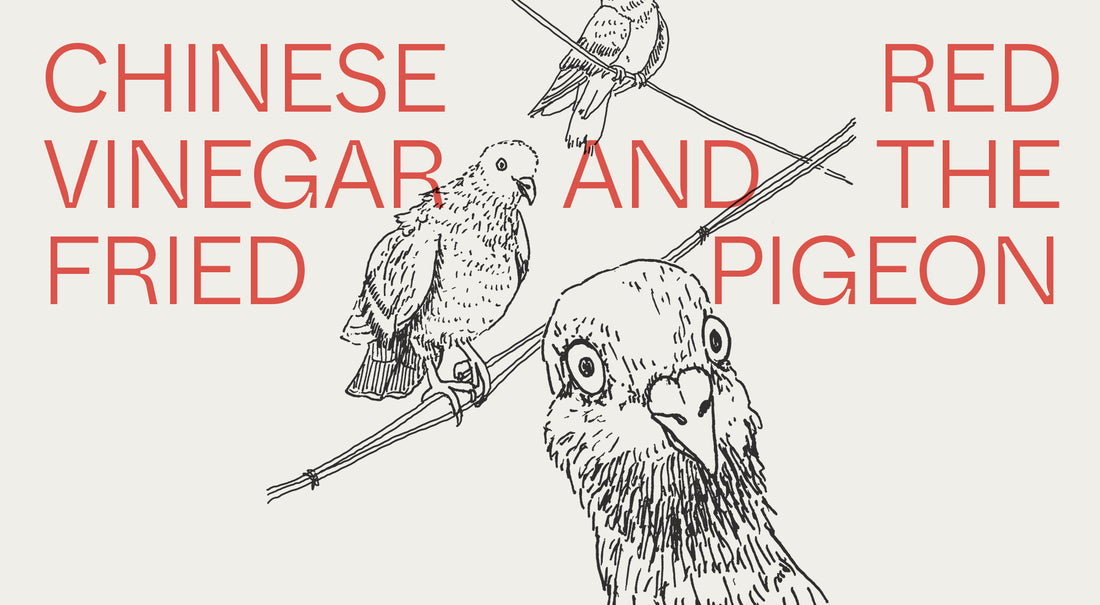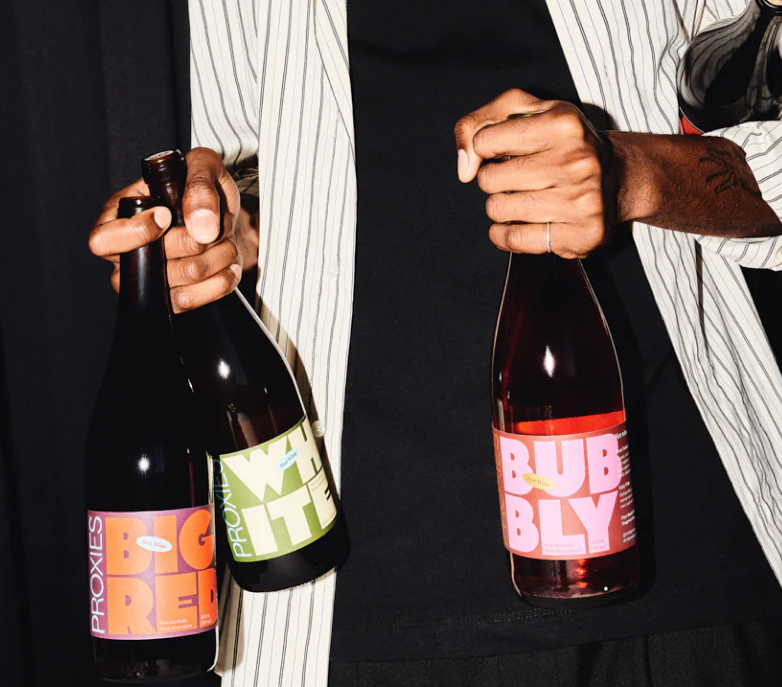
Chinese Red Vinegar & The Fried Pigeon
Share
Words by Zachary Schwartz, Art by Reena Mistry
I'm going to where the sun burns / And the heat stays in command / Come and lay by my side / Right here / Red, I love you and the world - Daniel Lanois, “Red”
“Dear God, what is that?!” my colleague yelled as his eyes bungeed out of his face.
I had just returned from lunch and I was carrying a small plastic container of squid congee stained scarlet by red vinegar. To virgin eyes, it looked like bloody oatmeal.
I smirked and placed the container on my desk. For the rest of the afternoon, as the congee grew cold, I took periodic sips, tilting my head back and guzzle-savoring the rubbery squid flesh, the crunchy strands of ginger, and, best of all, the tart acidity of the red vinegar. With each sip, my coworkers gaped and guffawed.
These were the same people who excitedly ordered pho, pad thai, and sushi to the office; the same people who doused their hamburgers with Sriracha sauce. As a Taiwanese-American, I grew up eating pho, pad thai, sushi, and Sriracha, and get annoyed by the feigned fluency some Westerners have with these foods. Yet to my great amusement, there are still Asian ingredients too strange and befuddling for the Western mind to handle.
Congee is a Chinese classic: a thick rice porridge, often filled with different meats, that’s best enjoyed on a wintry day. What I discovered early on in my life, at the Cantonese restaurants my family would frequent, is that a generous helping of red vinegar elevates congee to the sublime.
There are five different types of rice vinegar: black (the most common), brown, yellow (seasoned), white, and red. Red is the rarest, and the hardest to find outside China. The vinegar’s distinctive red-hue comes from the dark purple-red Monascus mold that grows on the rice, in contrast to the more commonly used white Aspergillus mold. Monascus mold not only imparts color, but also produces red vinegar’s unique flavor profile: sweet, salty, and a hint of tart.
Even Chinese cooks rarely use red vinegar. In my lifetime, I've only seen it used to flavor congee or similarly thick broths like West Lake Beef soup. But with these dishes, it is a necessity. In fact, red vinegar is my litmus test of the authenticity of a restaurant serving congee: if they have none, I take out my newspaper, cross my legs, and refuse all further service. If I have to ask for it, and they bring it out on a spoon, I eye them with barely concealed contempt. If it’s a tabletop fixture, I smile with the light of a thousand suns.
Recently, I moved to Brooklyn for a few months. The first place I visited was not some tourist attraction, but the local Asian supermarket. I shoveled all my staple ingredients into my shopping basket: soy sauce, Shaoxing wine, mirin, men-tsuyu stock, hon-tsuyu stock, dashi powder—but then something caught my attention.
Red. The translucent glass bottles posed like terra-cotta soldiers on the lowest shelf. Hanging vines of memory crept down from the ceiling, wriggled through my ears, and pushed down on my brain. I knelt and snatched the red vinegar. I threw it in my shopping cart, grabbed everything else I needed, and hurried out.
In the following weeks, I used most of the ingredients: hon-tsuyu and men-tsuyu stock for udon soup, mirin for karaage chicken and onsen tamago eggs, dashi stock for miso soup and oyakodon. The red vinegar sat neglected in the back of my cupboard—no Chinese, Japanese, or Taiwanese recipes called for its use, and I couldn’t figure out a dish to pair it with. Finally, one sleepless night, I turned to the Internet for answers.
Google confirmed that red vinegar is primarily used as a condiment for congee and similar soups, but in the recesses of one cooking website I discovered something new. A dish I had never seen before. A traditional dish where red vinegar was a necessity. A recipe for Chinese fried pigeon.
I began to salivate like a cat watching a bird behind glass. Unfortunately, the website informed me that the dish is all but impossible to find in North American restaurants due to the complexity of its preparation and the rarity of red vinegar. I knew then what I needed to do.
It was time to fry a pigeon.
But where to find a pigeon?
In New York City, pigeons are “the rats of the skies.” I strongly considered grabbing my pistol and brazenly firing into a sidewalk flock of birds. But if Red Dead Redemption 2 taught me anything about hunting, it’s that you need a varmint rifle for small game or else you’ll spoil the meat.
Also, guns are virtually banned in New York. Neutered by the rules of civilization, I resolved to buy a squab—a young domestic pigeon bred for consumption.
But where to find a squab?
In New York, you could probably buy a monkey if you searched hard enough. I called a specialty butcher shop. “Excuse me, do you sell pigeon?” I asked in my friendly Midwestern intonation. “Eh…what? What you say to me? A pigeon?” He slammed the phone down.
I called back. “Hi, do you guys sell squab?” “Ah, squab…yes, yes…give me one second…yes, we have squab. Frozen.” “Okay, I’ll be there in an hour or so.”
At the shop, the butcher silently beckoned me to follow him. We walked to the back of the store, through a deadbolted door, and finally into a dimly lit room where I recognized none of the meats around me. The butcher knelt down and from the lowest shelf produced a frozen squab. He handed it to me with a curt nod. I paid in cash.
Back home, I slapped the hunk of frozen pigeon on the counter, then arranged the red vinegar next to it. Rice and pigeon. One belonged to the earth, one belonged to the sky. But in the afterlife, they would be compatriots.
After thawing the pigeon for a few hours, I set to work on the complicated recipe. First, I scooped out the entrails with my fingers. Then I boiled a pot of water, adding green onion, ginger, garlic, a Chinese spice braising packet, Shaoxing wine, and other ingredients, and immersed the pigeon in the bubbling broth for 30 minutes.
Once out of its bath, I coated my precious pigeon in a dissolved mix of maltose, Shaoxing wine, and, most importantly, red vinegar. According to lore, the rare red vinegar helps the bird’s skin crisp when fried, in addition to bestowing heavenly taste.
Next, I stood over the bird with a hair dryer. The squab needed to be dry before hitting the oil and I was getting hungry. Soon enough, it was ready. I filled a deep pan with oil and waited until it began sputtering. I placed the squab in a strainer and lowered it into the pan. With a ladle, I continuously poured hot oil over the pigeon flesh, watching the color change from white to red.
After a few minutes, the pigeon’s dark amber skin glistened like a warm fire. A fragrant aroma filled the kitchen. It was time to eat.
Using my bare hands, I tore into the pigeon, savoring every bite. The crunchy, vinegary skin was the main attraction; the meat merely fleshy backdrop. Citrusy, and savory flavors criss-crossed upwards and exploded in fireworks—the shimmering, tart aftertaste painted the sky red.
After finishing the pigeon, I wiped my greasy lips and sat back in contentment. I slapped my belly three times, groaned, and immediately fell asleep.
Post-pigeon, I began experimenting with red vinegar more. I now mix it with soy sauce and use it as a dip for dumplings and scallion pancakes. I’m experimenting with incorporating it into Cantonese poached chicken. And I’m considering carrying it in my bag like hot sauce.
In some future timeline, people may eventually discover red vinegar like they are now discovering congee. They’ll tell me all about its striking color, its salty backbone, and its “authenticity,” like they tell me now about tiger balm or soup dumplings. I’ve come to accept that as okay. Such is the way that culture moves around the world.
But then I’ll tell them about the fried pigeon, and their faces will contort into shock and awe, and I will smirk, and I will know that no matter what, I will always stay one step ahead.
When I see you behind the glass / I forget that I’m the cage / They bring me to Sunday mass / But it never wiped the rage / Red, I love you and the world - Daniel Lanois, “Red”
A version of this article originally appeared in Acid League Magazine Volume 1.
Zachary Schwartz is a writer from Cleveland, Ohio. His stories have been published in Rolling Stone, Playboy, Vice, New York Tyrant, and other publications.





